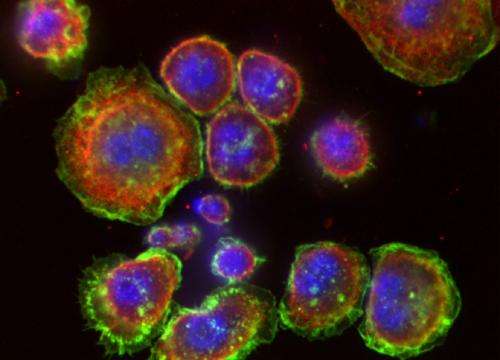Changes in cell shape may lead to metastasis, not the other way around

(Phys.org) —A crucial step toward skin cancer may be changes in the genes that control cell shape, report a team of scientists from The Methodist Hospital Research Institute, the Institute of Cancer Research, London, and Harvard Medical School in an upcoming issue of Nature Cell Biology.
Using automated high content screening and sophisticated computational modeling, the researchers' screening and analysis of tens of millions of genetically manipulated cells helped them identify more than a dozen genes that influence cell shape. Their work could lead to a better understanding of how cells become metastatic and, eventually, pinpoint new gene therapy targets for cancer treatment.
"We found that by altering the way the cells are grown to better mimic conditions in a living organism, gene expression could have a profound impact on cell shape," said Zheng Yin, the paper's lead author and a postdoctoral fellow at the Department of Systems Medicine and Bioengineering of The Methodist Hospital Research Institute (TMHRI). "This matters because many cancer biologists believe metastasis depends in part on the ability of cells to take on different shapes to escape their confines and spread to healthy tissue. We developed a method of identifying and analyzing the shapes of fruit fly cells, then validated and expanded the discoveries in mammal cancer cells.."
The scientists began their study in fruit fly immune cells called hemocytes. Under normal conditions, each hemocyte was found to take on just one of five distinct shapes about 98 percent of the time. In contrast to conventional wisdom, other shapes and "intermediate" forms were rare, suggesting genes that control cell shape behave more like light switches than teakettles coming to a slow boil. Genetic manipulation of these cells in a lab setting supported that view as well.
Next the group examined human and mouse melanoma cells, which also take on a variety of forms. The researchers identified seven genes that cause cells to take on an especially rounded form, or else an elongated form. One of these genes, PTEN, had a particularly strong impact. When turned off, virtually all cells became elongated or large and rounded, two shapes that can help cancerous cells escape confinement, travel blood vessels, and infiltrate healthy tissues. This information about PTEN is new, even though the gene was previously known to scientists as a tumor suppressor.
"By increasing the frequency of rounded and elongated cells this would provide metastatic cells with a survival advantage that is otherwise not gained by adopting only a single shape, or being highly plastic," said TMHRI Department of Systems Medicine and Bioengineering Chair Stephen T.C. Wong, Ph.D., P.E., who with Institute of Cancer Research, London, Fellow Chris Bakal, Ph.D., are the corresponding authors who oversaw the research.
Bakal added, "The cells have to become rounded to travel through the bloodstream or invade soft tissues such as the brain, but they take on an elongated shape to travel through harder tissues like bone. But until now, we knew hardly anything about how the cells assume either of these shapes and how they switch between the two."
Yin said he hopes data from the study will be useful to cell and developmental biologists who are interested in how and why many different kinds of animal cells change their shapes.
"I believe this dataset has great potential," he said. "We still saw three distinct shapes other than rounded and elongated, and a handful of cell populations enriched with intermediate shapes—a lot of possibilities for hypothesis generation."
Journal information: Nature Cell Biology
Provided by The Methodist Hospital System


















